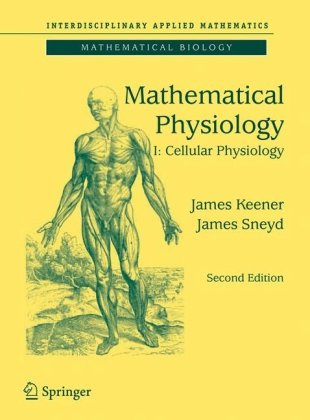James Keener, James Sneyd (auth.), James Keener, James Sneyd (eds.)9780387758466, 0387758461, 9780387094199, 0387094199, 9780387793870, 0387793879
There has been a long history of interaction between mathematics and physiology. This book looks in detail at a wide selection of mathematical models in physiology, showing how physiological problems can be formulated and studied mathematically, and how such models give rise to interesting and challenging mathematical questions. With its coverage of many recent models it gives an overview of the field, while many older models are also discussed, to put the modern work in context.
In this second edition the coverage of basic principles has been expanded to include such topics as stochastic differential equations, Markov models and Gibbs free energy, and the selection of models has also been expanded to include some of the basic models of fluid transport, respiration/perfusion, blood diseases, molecular motors, smooth muscle, neuroendrocine cells, the baroreceptor loop, turboglomerular oscillations, blood clotting and the retina.
Owing to this extensive coverage, the second edition is published in two volumes. This first volume deals with the fundamental principles of cell physiology and the second with the physiology of systems.
The book includes detailed illustrations and numerous excercises with selected solutions. The emphasis throughout is on the applications; because of this interdisciplinary approach, this book will be of interest to students and researchers, not only in mathematics, but also in bioengineering, physics, chemistry, biology, statistics and medicine.
James Keener is a Distinguished Professor of Mathematics at the University of Utah. He and his wife live in Salt Lake City, but don’t be surprised if he moves to the mountains.
James Sneyd is the Professor of Applied Mathematics at the University of Auckland in New Zealand, where he has worked for the past six years. He lives with his wife and three children beside a beach, and would rather be swimming.
Reviews of the first edition:
…probably the best book ever written on the interdisciplinary field of mathematical physiology. Mathematical Reviews, 2000
In addition to being good reading, excellent pedagogy, and appealing science, the exposition is lucid and clear, and there are many good problem sets to choose from… Highly recommended. Mathematical Biosciences, 1999
Both authors are seasoned experts in the field of mathematical physiology and particularly in the field of excitability, calcium dynamics and spiral waves. It directs students to become not merely skilled technicians in biological research but masters of the science. SIAM, 2004
The first edition was the winner of the 1998 Association of American Publishers “Best New Title in Mathematics.”
Table of contents :
Front Matter….Pages i-xxv
Biochemical Reactions….Pages 1-47
Cellular Homeostasis….Pages 49-119
Membrane Ion Channels….Pages 121-173
Passive Electrical Flow in Neurons….Pages 175-194
Excitability….Pages 195-228
Wave Propagation in Excitable Systems….Pages 229-271
Calcium Dynamics….Pages 273-346
Intercellular Communication….Pages 347-384
Neuroendocrine Cells….Pages 385-426
Regulation of Cell Functions….Pages 427-470
Back Matter….Pages –







Reviews
There are no reviews yet.